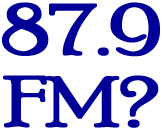 I was disappointed but unsurprised to learn about the end of Pirate Cat Radio’s unlicensed FM broadcast resulting from the FCC issuing a notice of apparent liability (NAL) to Pirate Cat’s operator Monkey Man a/k/a Daniel K. Roberts. However, I am surprised at how long Pirate Cat was able to make a go of it operating out in the open. Perhaps appearing on the Travel Channel’s No Reservations made it hard for the Commission to turn a blind eye much longer.
I was disappointed but unsurprised to learn about the end of Pirate Cat Radio’s unlicensed FM broadcast resulting from the FCC issuing a notice of apparent liability (NAL) to Pirate Cat’s operator Monkey Man a/k/a Daniel K. Roberts. However, I am surprised at how long Pirate Cat was able to make a go of it operating out in the open. Perhaps appearing on the Travel Channel’s No Reservations made it hard for the Commission to turn a blind eye much longer.
As Jennifer noted in her report, the FCC observed in a footnote to its NAL that, “the frequency used without authority by Roberts and PCR is 87.9 MHz, which is not allocated to the FM broadcast band.” Over email Jennifer asked me if using that frequency might be any sort of contributing factor for the FCC’s attention, especially in light of an unlicensed operator in Florida recently receiving a $2500 fine for broadcasting on the same frequency.
I was actually a little confused by the FCC’s footnote about 87.9 FM because I’d always understood that the frequency is considered part of the FM dial, though typically not assigned except under special circumstances. In fact, at present there are three stations licensed to 87.9 FM: KSFH in Mountain View, CA; K200AA in Sun Valley, NV, a translator in the Calvary Chapel of Twin Falls, ID CSN Network; and WA2XNX in Brazos, TX, an experimental station licensed to Federal Signal Corporation.
According to the Code of Federal Regulations title 47 section 73.501, “87.9 MHz, Channel 200, is available only for use of existing Class D stations required to change frequency.” These Class D stations are low-power 10 watt stations licensed prior to 1978, when the service ceased to exist. That’s the rule under which low-power high school station KSFH is licensed to 87.9 FM.
So, while it’s true that the Commission generally doesn’t license new stations to 87.9 FM, it’s simply not true that the frequency is not part of the FM broadcast spectrum as asserted in the NAL issued to Pirate Cat Radio. As to the question of whether using that frequency contributed to the FCC targeting Pirate Cat or the aforementioned Florida pirate, I think it’s quite unlikely. The NAL against the Florida pirate makes no mention of the frequency not being a legitimate part of the FM dial.
As far as the Commission is concerned any given unlicensed operator is no different than another. Each field office tends to have its own set of priorities about chasing down pirates, and looking at the list of enforcement actions you can definitely see that each office seems to have periodic bursts of action against unlicensed operators. By and large enforcement actions are complaint-based, and operating out in the open is more likely to result in a complaint than being clandestine.
I suspect that action against Pirate Cat, in particular, came about rather slowly, perhaps influenced by the positive publicity it received and the position of relative respect it has in the community. Of course, these factors will not stop the FCC from taking action against an unlicensed broadcaster; failing to take any action would only serve as an encouragement to others. But I do think that these factors complicate the Commission’s job, causing it to tread a little more carefully.
I think operating an unlicensed station on 87.9 FM is no more risky than operating on any other frequency. The fact that there are very few stations licensed to this frequency makes it attractive for pirates looking for a clear channel and to avoid interfering with other stations. The FCC’s recent decision that FM stations no longer need to protect channel 6 audio on the far left end of the dial may lead to erosion of this opportunity in some areas as more licensed stations encroach on 87.9 FM. Until then, the risk of being a pirate on 87.9 FM is due to being a pirate broadcaster, and nothing more.


